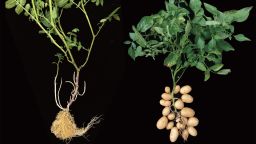Science
Wild Tomatoes in Galápagos Challenge Evolutionary Theories

In a remarkable discovery, wild tomatoes in the Galápagos Islands may be providing evidence for a phenomenon some scientists are calling “reverse evolution.” Researchers studying the plant species known as Solanum pennellii observed that tomatoes from younger islands in the archipelago show traits absent from their modern relatives. This finding, reported in the journal Nature Communications in June 2024, suggests that these plants may have reverted to an earlier evolutionary state.
Located hundreds of miles off the coast of Ecuador, the Galápagos Islands have long been associated with Charles Darwin and his groundbreaking work on evolution. During their study, the research team, which included molecular biochemist Adam Jozwiak from the University of California, Riverside, found that the western islands’ tomatoes produced alkaloids not seen in the species for millions of years. The western Solanum pennellii exhibited a molecular fingerprint more akin to that of eggplants, indicating a significant deviation from the modern tomato.
The research focused on samples collected from both the younger and older islands, revealing stark differences. While the tomatoes from the eastern islands displayed a contemporary defense system, those from the western regions appeared to have reverted to ancestral characteristics. “It’s not very common to see reverse evolution,” Jozwiak remarked, emphasizing how environmental pressures may have influenced this reversion.
The physical characteristics of the western tomatoes also stood out. They featured a purplish hue and darker vines, contrasting with the brighter colors typically associated with the species. On a molecular level, the analysis of 30 tomato samples showed that the western varieties retained ancient genetic traits, potentially allowing them to thrive in the harsher conditions of the younger islands.
Understanding the implications of this discovery could lead to advancements in agriculture and pest control. By examining the ancient genes that have re-emerged, scientists hope to develop stronger crops and more effective pesticides. Furthermore, this research may offer insights into broader evolutionary processes, potentially even in humans.
Environmental Factors and Evolutionary Flexibility
The origins of Solanum pennellii trace back to South America, likely arriving in the Galápagos through birds transporting seeds. Jozwiak estimates this migration occurred between 1 million and 2 million years ago, coinciding with the formation of the younger islands due to volcanic activity. The environmental conditions on these islands differ significantly from those on the eastern islands, which have a more stable ecosystem.
Jozwiak hypothesizes that the unique combination of ancient genes and the toxic molecular cocktail produced by these tomatoes help them fend off predators while also boosting nutrient absorption. The research revealed that a simple change in amino acid composition led to the re-emergence of these ancestral traits.
Further investigations are necessary to grasp the full extent and benefits of these transformations. Jozwiak plans to return to the islands to explore how these ancient traits may affect plant interactions with insects and their decomposition rates.
Challenging Established Evolutionary Concepts
While the concept of reverse evolution may seem radical, it is not entirely unprecedented. Evolutionary biologist Anurag Agrawal from Cornell University noted that many evolutionary processes involve detours and reversions. He cited examples like cave-dwelling animals losing their eyesight and certain birds losing the ability to fly. “Most evolutionary biologists would reject evolution as a forward process; it is more of a tinkering process,” Agrawal explained.
The notion of reverse evolution challenges Dollo’s Law, which asserts that once a trait is lost, it cannot be regained in the same form. Eric Haag, a professor of biology at the University of Maryland, highlighted that the findings in Galápagos tomatoes could complicate this principle. While the tomatoes regained ancestral genes, they also retained modern alkaloids, indicating a complex evolutionary history.
Scientists continue to debate the implications of this research. Jozwiak indicated that viewing evolution as a more flexible process could reveal other species undergoing similar developments. The possibility of humans experiencing a form of “reverse evolution,” where ancestral traits resurface, remains a topic of interest among researchers.
The exploration of these wild tomatoes serves as a powerful reminder of the complexities of evolution. As scientists unravel the genetic mysteries of Solanum pennellii, the findings may reshape our understanding of how species adapt and survive in changing environments.
-

 Science2 weeks ago
Science2 weeks agoInventor Achieves Breakthrough with 2 Billion FPS Laser Video
-

 Top Stories2 weeks ago
Top Stories2 weeks agoCharlie Sheen’s New Romance: ‘Glowing’ with Younger Partner
-

 Entertainment2 weeks ago
Entertainment2 weeks agoDua Lipa Aces GCSE Spanish, Sparks Super Bowl Buzz with Fans
-

 Business2 weeks ago
Business2 weeks agoTyler Technologies Set to Reveal Q3 Earnings on October 22
-

 World2 weeks ago
World2 weeks agoR&B Icon D’Angelo Dies at 51, Leaving Lasting Legacy
-

 Health2 weeks ago
Health2 weeks agoNorth Carolina’s Biotech Boom: Billions in New Investments
-

 Entertainment2 weeks ago
Entertainment2 weeks agoMother Fights to Reunite with Children After Kidnapping in New Drama
-

 Science2 weeks ago
Science2 weeks agoNorth Carolina’s Biotech Boom: Billions Invested in Manufacturing
-

 Health2 weeks ago
Health2 weeks agoCurium Group, PeptiDream, and PDRadiopharma Launch Key Cancer Trial
-

 Entertainment2 weeks ago
Entertainment2 weeks agoRed Sox’s Bregman to Become Free Agent; Tigers Commit to Skubal
-

 Top Stories2 weeks ago
Top Stories2 weeks agoDisney+ Launches Chilling Classic ‘Something Wicked’ Just in Time for October
-

 Health2 weeks ago
Health2 weeks agoCommunity Unites for 7th Annual Into the Light Walk for Mental Health









